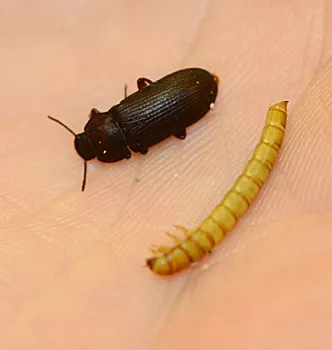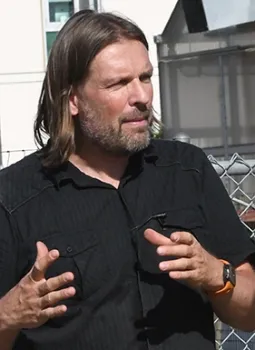UC Davis Graduate Student Scores EPA Grant Involving Mealworms and Styrofoam

Fowles, a second-year doctoral student in the UC Davis Department of Entomology and Nematology, just received a $15,000 grant from the Environmental Protection Agency for his research on “Beetle Larvae as Biodegraders of Styrofoam and Organic Waste” and now has an opportunity to score a $75,000 grant.
Meanwhile, his 100,000 mealworms in the Briggs Hall lab of his major professor Christian Nansen, are munching away in a project that Fowles hopes will make a difference in breaking down Styrofoam--especially a problem in the nation's landfills--and offer sustainable environmental solutions.
The larvae of the darkling beetle larvae, Tenebrio molitor, eat polystyrene or plastic foam, generically known as Styrofoam, a fact first revealed in 2015 by Stanford University researchers.
“It's about insects processing waste,” Fowles said of his research. “In three weeks they ate three-fourths of a pound of Styrofoam, converting it into biodegradable waste.”
“Trevor's project should be viewed as an example of what entomological agricultural research is all about in the 21st Century--developing new and highly innovative ways to recycle resources and more sustainable food production systems," said agricultural entomologist Christian Nansen, an associate professor of entomology who specializes in applied insect ecology, integrated pest management (IPM) and remote sensing.
In addition, the project has an applied evolutionary angle, which Fowles intends to explore.

Fowles received one of 31 Phase 1 grants in in the National Student Design Competition for Sustainability Focusing on People Prosperity and the Planet (P3), amounting to $463,000 in funding. His project now advances to the Phase 2 level, to take place April 7-8 at the National Sustainable Design Expo at the Science and Engineering Festival in Washington, DC.
In his research project, Fowles seeks to design a pilot-scale styrofoam biodegradation unit to take in regional styrofoam and organic waste, and establish a high-performance beetle lineage, or the “best beetle larvae to do the job.” The adult beetles also eat Styrofoam, but not as much.
“Organization of our food systems will be a defining challenge in the upcoming century and I believe insects will play a significant role in transforming our agricultural sectors,” Fowles said.
His design emphasizes economic feasibility, community engagement, and environmental stewardship. To be sustainable, the project is aimed at connecting local community stakeholders with research expertise to produce an ecofriendly alternative for styrofoam disposal. Fowles is zeroing in on four components to meet these objectives:
- optimizing parameters influencing styrofoam biodegradation
- modeling and designing a pilot system that maximizes degradation and nutritional value of beetle larvae
- project integration in collaboration with local agricultural producers and waste management to meet real world waste demands and
- community engagement to share the novel aspect of this concept and educate local school children about the concepts of sustainability.
After biodegrading the styrofoam, the beetles can be pelletized for animal feed, Fowles said, and the excrement or frass can be used as “high-value amendment to compost mixtures.” He figures that that since Styrofoam by itself is a poor nutrient source for the beetle larvae, he eventually will mix it with organic waste materials, such as, pulp from wine and tomato industries, to optimize beetle development.
The darkling beetles and larvae are pests of stored grains, but the larvae are widely used throughout the world as food for humans; for captive pets, including fish, reptiles and birds; and as fish bait. They are reared commercially on fresh oats, wheat bran or grain, and often with sliced potato, carrots, or apple as a moisture source.
In the wild, darkling beetles and larvae are general decomposers, eating decaying leaves, sticks, grasses, and carcasses.
Fowles said he received his first colony of mealworms in 2016 from then graduate student Tom Nguyen at the Bohart Museum of Entomology, now a researcher at the Smithsonian Institution. Fowles purchased his 100,000 mealworms from the insect farm, Rainbow Mealworms and Crickets in Compton.
Fowles, who grew up in West Sacramento, received his bachelor's degree in biology in 2011 from San Diego State University. Before entering the UC Davis graduate student program, he served as a lab manager for five years for Carroll/Loye Biological Research, launched by the UC Davis entomological team of Scott Carroll and Jenella Loye.
In a news release, EPA Administrator Scott Pruitt said: “This year's P3 teams are applying their classroom learning to create valuable, cutting-edge technologies. This next generation of scientists is designing sustainable solutions that will help protect public health and the environment and ensure America continues to lead the world in innovation and science for decades to come.”
